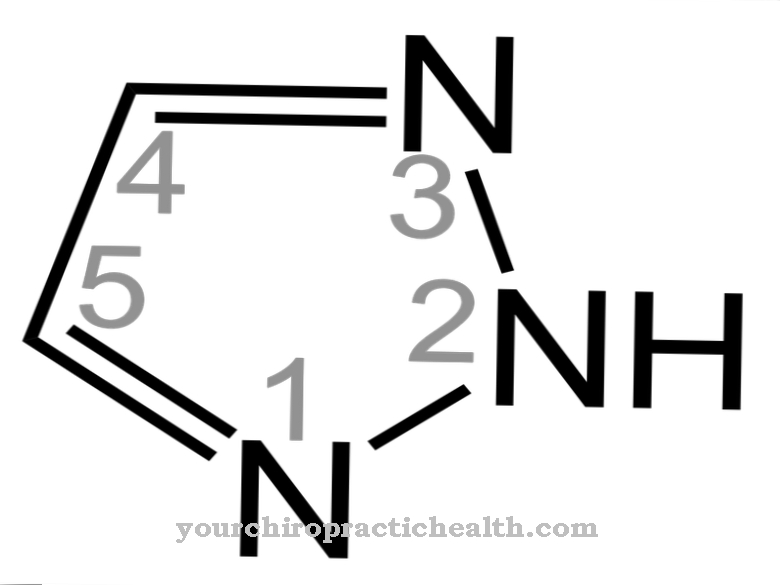Chlorpromazine is a chemical substance that was synthesized for the first time in France in 1950 and, due to its effects, became a basic component of the group of drugs known as psychotropic drugs. Among the psychotropic drugs, chlorpromazine is the oldest active antipsychotic drug (so-called neuroleptic).
What is chlorpromazine?

Chlorpromazine As a chemical substance, it belongs to the phenothiazine class. These are a group of organic substances that are often used as medicines, insecticides or dyes.
In terms of its medicinal properties, the agent is classified as a neuroleptic with medium potency. For the so-called neuroleptic potency, the following generally applies to conventional neuroleptics:
The lower this potency of a substance, the higher the sedative effect and the dose that is required for side effects to set in. A dose between 25 mg - 400 mg causes side effects in the case of chlorpromazine.
Pharmacological effect
Chlorpromazine Like all neuroleptics, it generally has a symptomatic effect. This means that as a drug, it combats and alleviates the symptoms of a disease, but does not eliminate the cause.
It develops its pharmacological effect directly in the brain, where it influences the metabolism of neurotransmitters (chemical messenger substances in nerve cells). The substance has an inhibitory effect on various receptors (docking points) for the neurotransmitter dopamine. By acting on these different receptors of the dopamine system in the nerve cells of the brain, it has a relatively broad effectiveness compared to other neuroleptics.
Sedating, antisychotic, antihistaminic (antiallergic), antiemetic (affecting vomiting and nausea) as well as anticholinergic (affecting muscles and glands) and antiadrenergic (affecting the effect of adrenaline) on the body are known when chlorpromazine is taken.
Medical application & use
Chlorpromazine As a psychotropic drug, it has a sedating and antipsychotic effect, it is against the so-called loss of reality in mental disorders and diseases such as Schizophrenia or mania effective.
It combats symptoms such as hallucinations, delusions, but also anxiety and restlessness. After its discovery, the potent substance was used against a number of mental disorders, such as anxiety, delusions and manias, due to its broad effectiveness. Ultimately, however, the highest specific effectiveness of the drug was shown against the psychomotor restlessness, which occurs above all in schizophrenia.
In addition to treating mental illnesses, neuroleptics are also used to combat the symptoms of poisoning with psychogenic drugs such as LSD or toadstools. Since the substance sedates the patient, but the relief of psychogenic symptoms such as delusion or hallucinations is often not strong enough, the neuroleptically effective drug is usually not used as the sole agent of choice.
If chlorpromazine is medically prescribed, the average dose, depending on age and weight, is 25 mg to 400 mg per day, the maximum dose is 800 mg per day.
You can find your medication here
➔ Medicines to calm down and strengthen nervesRisks & side effects
Chlorpromazine is a moderately potent neuroleptic, which corresponds to a medium dose for triggering side effects. These occur when taking neuroleptics, especially over a longer period of time, and can be varied.
In such cases, the so-called extrapyramidal side effects, which are movement disorders, are common. These come from the central nervous system and are similar to the symptoms of Parkinson's. Other side effects that occur with higher doses and prolonged use of the psychotropic drug are sedation and lowering of blood pressure. But there are also symptoms such as a disruption of the body's heat regulation (rapid overheating or cooling down at corresponding temperatures) and allergic reactions of the skin and functional disorders of the liver.
Other possible side effects can be photosensitivity, thrombosis (formation of blood clots in the vessels), disturbance of potency or menstrual disorders as well as a lack of white blood cells (leukopenia). In rare cases, when taking chlorpromazine, so-called cholestatic hepatosis can occur, which is an allergic-toxic blockage of the biliary tract with biliary obstruction, which can ultimately lead to fatal damage to the liver.












.jpg)



.jpg)










.jpg)
